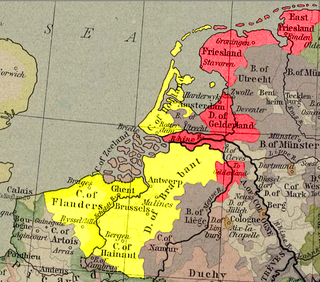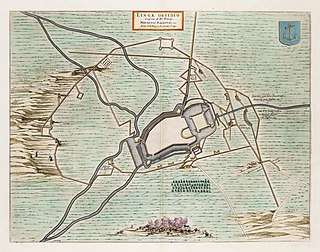
The Seventeen Provinces were the Imperial states of the Habsburg Netherlands in the 16th century. They roughly covered the Low Countries, i.e., what is now the Netherlands, Belgium, Luxembourg, and most of the French departments of Nord and Pas-de-Calais (Artois). Also within this area were semi-independent fiefdoms, mainly ecclesiastical ones, such as Liège, Cambrai and Stavelot-Malmedy.

Charles Martin, called the Bold, was the last duke of Burgundy from the House of Valois-Burgundy, ruling from 1467 to 1477. He was the only legitimate son of Philip the Good and his third wife, Isabella of Portugal. As heir and as ruler, Charles vied for power and influence with rivals such as his overlord, King Louis XI of France. In 1465 Charles led a successful revolt of Louis's vassals in the War of the Public Weal.

Mary of Burgundy, nicknamed the Rich, was a member of the House of Valois-Burgundy who ruled the Burgundian lands, comprising the Duchy and County of Burgundy and the Burgundian Netherlands, from 1477 to her death.
The music of Belgium is a cultural mix where Flemish Dutch-speaking and Walloon French-speaking traditions mix with those of German minorities and of immigrant communities from Democratic Republic of the Congo or other distant countries.

The Eighty Years' War or Dutch Revolt was an armed conflict in the Habsburg Netherlands between disparate groups of rebels and the Spanish government. The causes of the war included the Reformation, centralisation, excessive taxation, and the rights and privileges of the Dutch nobility and cities.

Margaret of Austria was Governor of the Habsburg Netherlands from 1507 to 1515 and again from 1519 until her death in 1530. She was the first of many female regents in the Netherlands. She was variously the Princess of Asturias, Duchess of Savoy, and was born an Archduchess of Austria.
The lance fournie was a medieval equivalent to the modern army squad that would have accompanied and supported a man-at-arms in battle. These units formed companies under a captain either as mercenary bands or in the retinue of wealthy nobles and royalty. Each lance was supposed to include a mixture of troop types that would have guaranteed a desirable balance between the various components of the company at large; however, it is often difficult to determine the exact composition of the lance in any given company as the available sources are few and often centuries apart.

The Burgundian Netherlands were those parts of the Low Countries ruled by the Dukes of Burgundy during the Burgundian Age between 1384 and 1482. Within their Burgundian State, which itself belonged partly to the Holy Roman Empire and partly to the Kingdom of France, the dukes united these lowlands into a political union that went beyond a personal union as it gained central institutions for the first time.

The Dutch are an ethnic group native to the Netherlands. They share a common ancestry and culture and speak the Dutch language. Dutch people and their descendants are found in migrant communities worldwide, notably in Aruba, Suriname, Guyana, Curaçao, Argentina, Brazil, Canada, Australia, South Africa, New Zealand and the United States. The Low Countries were situated around the border of France and the Holy Roman Empire, forming a part of their respective peripheries and the various territories of which they consisted had become virtually autonomous by the 13th century. Under the Habsburgs, the Netherlands were organised into a single administrative unit, and in the 16th and 17th centuries the Northern Netherlands gained independence from Spain as the Dutch Republic. The high degree of urbanisation characteristic of Dutch society was attained at a relatively early date. During the Republic the first series of large-scale Dutch migrations outside of Europe took place.

The compagnie d'ordonnance was the first standing army of late medieval and early modern France. The system was the forefather of the modern company. Each compagnie consisted of 100 lances fournies, which was built around a heavily armed and armored gendarme, with assisting pages or squires, archers and men-at-arms, for a total of 600 men. By 1445, France had 15 compagnies, for an army of 9,000 men, of which 6,000 were combatants and 3,000 non-combatants. Over the course of the 15th century, the compagnies d'ordonnance expanded to a peak strength of 58 compagnies of 4,000 lances and 24,000 men in 1483. It was later supplemented by the bandes d'artillerie, the franc-archers militia after 1448 and standing infantry regiments from 1480 onward.

The Guelders Wars were a series of conflicts in the Low Countries between the Duke of Burgundy, who controlled Holland, Flanders, Brabant, and Hainaut on the one side, and Charles, Duke of Guelders, who controlled Guelders, Groningen, and Frisia on the other side.

Habsburg Netherlands refers to those parts of the Low Countries that were ruled by sovereigns of the Holy Roman Empire's House of Habsburg. This rule began in 1482 and ended for the Northern Netherlands in 1581 and for the Southern Netherlands in 1797. The rule began with the death in 1482 of Mary of Burgundy of the House of Valois-Burgundy who was the ruler of the Low Countries and the wife of Holy Roman Emperor Maximilian I of Austria. Their grandson, Emperor Charles V, was born in the Habsburg Netherlands and made Brussels one of his capitals.
Robert de Melun, viscount of Ghent and marquis of Roubaix, was a nobleman from the Low Countries who fought in the Eighty Years' War.

The siege of Lingen took place during the Eighty Years' War and the Anglo–Spanish War by a Dutch and English army led by Maurice of Orange. Frederik van den Bergh defended Lingen for Philip II of Spain which was besieged from 25 October 1597. After a siege of more than two weeks, Van den Bergh surrendered on 12 November 1597. The siege was part of Maurice's successful 1597 campaign against the Spaniards.

The County of Flanders was one of the most powerful political entities in the medieval Low Countries, located on the North Sea coast of modern-day Belgium and north-eastern France. Unlike the neighbouring states of Brabant and Hainaut, it was within the territory of the Kingdom of France. The counts of Flanders held the most northerly part of the kingdom, and were among the original twelve peers of France. For centuries, the economic activity of the Flemish cities, such as Ghent, Bruges and Ypres, made Flanders one of the most affluent regions in Europe, and also gave them strong international connections to trading partners.

Albert de Ligne (1600–1674), Prince of Barbançon and Arenberg, knight of the Golden Fleece, was a Netherlandish nobleman and military commander in the Thirty Years' War and the Eighty Years' War.
Events in the year 1873 in Belgium.

The Burgundian State was a polity ruled by the Dukes of Burgundy from the late 14th to the late 15th centuries, and which ultimately comprised not only the Duchy and County of Burgundy but also the Burgundian Netherlands. The latter, acquired piecemeal over time and largely through inheritance, was, in fact, their principal source of wealth and prestige. The Dukes were members of the House of Valois-Burgundy, a cadet branch of the French royal House of Valois, and the complex of territories they ruled is sometimes referred to as Valois Burgundy. The term "Burgundian State" was coined by historians and was not in contemporary use; the polity remained a collection of separate duchies and counties in personal union under the Duke of Burgundy.
The Maréchaussée were corps of soldiers in the armies of France initially put in charge of military policing and justice during the Middle Ages, and later extended to civilian responsibilities. They gradually coalesced into a police force with jurisdiction over the whole population on almost the entire territory of France. They retained powers of extraordinary justice until the French Revolution.













